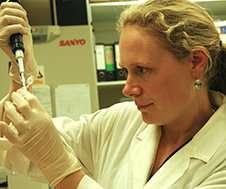Unique chemistry—which one day might help fight serious disease—found in the New Zealand glowworm

University of Otago researchers in New Zealand have helped uncover how New Zealand glowworms produce their glow. A multi-year study of the bioluminescence produced by the glowworms has been published today in the highly respected online science journal, Scientific Reports.
The study titled "New Zealand glowworm bioluminescence is produced by a firefly-like luciferase but an entirely new luciferin" was a collaborative effort between Otago's Chemistry and Biochemistry departments.
Lead authors Doctors Oliver Watkins and Miriam Sharpe, working with Professors Nigel Perry (Chemistry) and Kurt Krause (Biochemistry), have discovered that the New Zealand glowworms produce their light using a chemical reaction that is different to all other glowing creatures like fireflies.All light made by living creatures comes from chemical reactions that take place in enzymes called luciferases.
"What we have discovered is that the chemical, called a luciferin, which makes light in New Zealand glowworms, is unique, not used by any other glowing organism. However, the glow-worm luciferase enzyme is related to enzymes already found in other bioluminescent organisms like fireflies," says Dr Sharpe.
"No-one expected that this type of luciferase could make light with more than one kind of luciferin chemical."
Professor Krause says these findings are an important addition to our knowledge of glow-worms and notes that, the chemical that creates their glow could have important uses in the medical biotechnology sector.
"For instance, the light-generation taking place in the glowworm's 'taillight' could potentially be used in the laboratory to monitor cancer cells or to help identify infectious diseases. The chemistry behind some bioluminescent species, such as fireflies, is already used in scientific experiments world-wide. We believe the novel chemistry of the glowworms means their light could be used in similar kinds of experiments," says Dr Krause.
Professor Perry says for the full potential of glowworm's new chemistry to be exploited the next step is to synthesize the chemical compound that makes the light, i.e. the luciferin, in the laboratory. This is a key step to enable utilisation of the glowworm chemistry in any laboratory application.
The research team are now hoping to secure the funding needed to begin this synthesis and to continue their work.
Provided by University of Otago


















